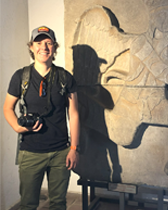Bihter Esener
College Fellow

- besener@northwestern.edu
- Kresge 4319
I was born and raised in Istanbul, Türkiye. My grandparents moved from Sultanahmet (located in the historical peninsula) to Küçükyalı (a modern-day town on the Anatolian side of Istanbul). I grew up minutes away from a Byzantine-era site, where Küçükyalı Archeopark excavations uncovered a palace with a monastery and a cistern occupied between the fifth and fourteenth centuries. I studied at Bilkent University in Ankara, Istanbul Bilgi University, and Koç University in Istanbul, where I received my Bachelor of Arts, Master of Art, and Doctor of Philosophy degrees respectively. I was a doctoral visiting student at Bryn Mawr College as well as a Freer Visiting Graduate Student in the Department of the History of Art at the University of Michigan (UM). I hold my doctoral degree from Koç University; however, I moved to Ann Arbor, Michigan, in 2019 and completed my dissertation there in 2022. Faculty, students, and staff in UM’s History of Art department have been kind and generous to me. My UM mentors, in particular Prof. Christiane Gruber, and colleagues have played an important role in my intellectual and professional development, so I am thrilled to be in Chicago and thus just a skip away from my other midwestern home of Ann Arbor.
How did you develop your area of study, and how has it modified or developed?
The 19th-century Danish philosopher Søren Kierkegaard argues that life must be lived forward, while it can only be understood backward. This holds true when I think about how my areas of study have developed over the years. When I was in high school, my favorite classes were Turkish literature and history, so I chose to study archaeology and history of art as an undergraduate student. When I was admitted to the Koç doctoral program, I studied with Prof. Suzan Yalman. Her scholarship inspired me to specialize in the art and architecture of Seljuk-period Anatolia: a diverse, rich, and complicated region and period. I have always enjoyed our discussions about medieval Anatolia, architectural history, art and archaeology, and popular culture. After taking my comprehensive exams, I spent the rest of my doctoral study and research abroad in the United Kingdom and the United States. I think traveling abroad and stepping out of my comfort zone, attending conferences, workshops, and meetings in different cities around the world, and meeting and exchanging ideas with professors, specialists, and graduate students contributed greatly to my intellectual and professional growth.
Can you tell us about your current book project? What are you working on right now that excites you the most?
My current book project provides the first comprehensive material and cultural study of Seljuk-period bronze mirrors in medieval Anatolia. It focuses on the broader functions of these objects in personal adornment and in devotional, divinatory, and talismanic practices between the late eleventh and early fourteenth centuries. This study builds on earlier scholarly works that focused on the physicality of mirrors, but it takes these studies in a new direction by drawing on evidence of the daily and ceremonial use of bronze mirrors from a broad range of hitherto neglected texts, a variety of media, and shared cross-cultural iconographies. It also goes beyond discussing what is or is not “Islamic”: instead, it proposes a pathway to study a new kind of history that explores the ways in which, why, and how these so-called “Islamic” bronze mirrors circulated among medieval Anatolia’s Christian, Jewish, and Muslim communities. Through my investigation of portable bronze mirrors, I aim to pinpoint the dynamic cross-cultural currents of such interconnected material cultures.
Additionally, the adaptation of the medieval world in popular culture—including historical video games, films, and books, as well as recent developments in artificial intelligence, augmented reality, and virtual reality—are of great interest to me. In Fall 2023, I taught “Medievalism in Video Games: Art, Culture and Theory,” a course in which my students examined the neo-medievalist tropes in historical video games while they were learning about the visual and material culture of the global Middle Ages. I look forward to meeting and chatting with students who are interested in digital tools, games, and art history.
What do you enjoy most about teaching?
I love being in the classroom with my students. Teaching is an organic and dynamic experience because each student has a different learning style: they can be visual, auditory, or tactile learners. I like to hear what they find most interesting. My goal is to provide them with a safe and encouraging environment that enables them to ask questions fearlessly; posing challenging queries is one of the most important elements of learning. I myself enjoy listening to my students’ stories, discussions, and questions; as a pedagogue, this is how I create personal and intellectual connections with them. My UM mentor, Prof. Christiane Gruber, once said that teaching would alter my research, and creating bonds with my students has changed the ways I approach both my research and teaching.
What made you particularly interested in coming to Northwestern?
Chicago Bulls, Batman, George R. R. Martin, NU Formula Racing, and SUE the T. Rex. But on a more serious note: I am excited to join a thriving Art History department in a university with such a depth and richness of resources. The first professorship of Islamic art and architecture in the United States was established at the University of Michigan in the Midwest during the 1930s, so I would like to continue to build on this tradition at Northwestern. I want to contribute to the growth of Islamic Art in Chicago and more broadly in the Midwest by collaborating with my colleagues at other prominent institutions. After all, the Midwest is a place I have called “home” since 2019 and I like to continue living and working here.
